Welcome to Submarine 101!
Submarines play a central role in my books, so I thought it’d be a great idea to provide an introduction to the U.S. Navy’s nuclear powered submarines from someone who served aboard four different ones. Sort of a “Submarine 101” introductory course. The topics are broken down into 15 segments:
1) Types of Submarines
2) Layout - Inside the Submarine
3) Armament (Weapons and Countermeasures)
4) Submarine Crews
5) Deployment Information and Preps
6) Underwater Operations
7) The Daily Routine
8) The Food
9) The Air and Water
10) Training and Inspections
11) Halfway Night and other Rituals
12) Submarine Pranks
13) Unusual Operations
14) When Things Go Wrong
15) Homecoming
All right, let’s get started!
Topic 1: Types of Submarines
The Size of Modern Submarines - Not What You Imagined!
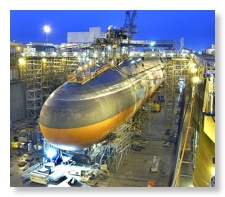
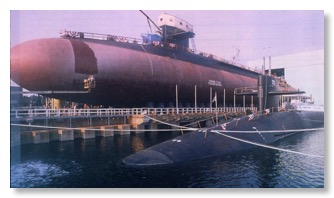
Types of Submarines - Fast Attacks (SSNs)
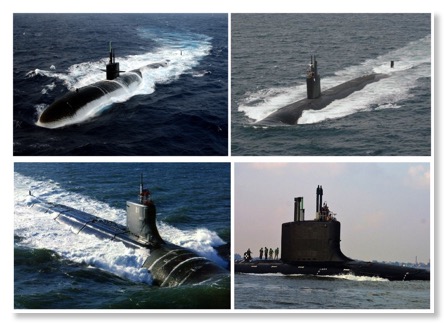
- We have 3 Seawolfs, huge Cold War submarines with 8 torpedo tubes, capable of carrying 50 torpedoes each. These are very capable submarines but came with a corresponding price tag, and with the end of the Cold War, the Navy needed a more affordable submarine.
- Enter the Virginia class, with 10 of them in-service as of 2013, leveraging the Seawolf and even more innovative technology.
- The top two pictures are Los Angeles class submarines. Notice the top left submarine has "Sail Planes" while the top right doesn't. The Navy moved to bow planes vice sail planes during the construction of the Los Angeles class. The Seawolf is the bottom left and the Virginia is the bottom right. Note the funky shape of the front of the sail, which is that way for hydrodynamic purposes, reducing drag through the water at high speed.
Types of Submarines - Ballistic Missile Submarine (SSBN)
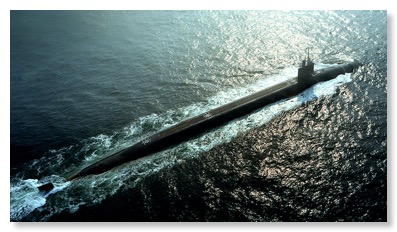
- Each SSBN can carry 24 missiles, with each missile carrying multiple warheads, and every second of every day, there are always several SSBNs at sea on Alert patrol, ready to launch its missiles at a moment's notice. When people talk of the nuclear "Triad", they're referring to the triad of nuclear launch platforms - bombers, land-based ICBMs, and SSBNs.
- SSBNs are the only survivable leg of the Triad against an enemy attack, because no one knows where they are when they are at sea, not even our own Navy.
Types of Submarines - Guided Missile Submarine (SSGN)
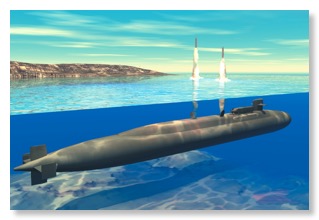
- With START nuclear warhead limitations, the Navy had four extra Trident submarines, and rather than decommission them with 20 years of life left, the Navy converted them into special warfare platforms.
- 22 of the 24 missile tubes are modified to carry Tomahawk missiles in 7-pack launchers, with the 2 remaining tubes modified into access trunks to Dry Deck Shelters (DDS) if they are attached to the submarine's Missile Deck. Each DDS is capable of carrying a SEAL Delivery Vehicle (SDV), a 4-man min-sub.
Return to List of Topics
Topic 2: Layout - Inside the Submarine
Welcome to the second topic of Submarine 101, where I’ll be taking you inside the U.S. Navy's nuclear powered submarines. I'll start with a basic overview.
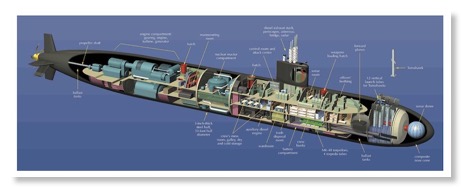
- Operations (or Forward) Compartment
- Reactor Compartment
- Engine Room
Additionally, the Ohio class (Trident) submarines (SSBNs and SSGNs) also have a Missile Compartment between the Operations Compartment and Reactor Compartment.
- Within each compartment, there are spaces, such as the Control Room, Torpedo Room, Berthing, or Auxiliary Machinery Room, or sometimes a space is simple referred to as a level:
- Engine Room Lower Level
- Missile Compartment 2nd Level
Although not a compartment or level, let's start with the space in the top of the submarine's Sail, called the Bridge Cockpit, or simply the Bridge.
Inside the Submarine - The Bridge
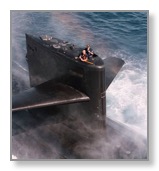
Inside the Submarine - Operations Compartment
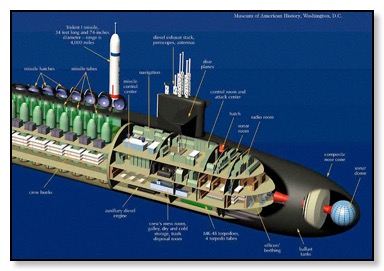
- Control Room
- Sonar Room
- Radio Room
- Torpedo Room
- Berthing (although enlisted berthing is in the Missile Compartment on Ohio class submarines)
- Crews Mess and Wardroom (I’ll talk about those spaces in the Food section)
- Auxiliary Machinery Space / Room
- Battery Compartment
I'll start with the Control Room.
Inside the Operations Compartment - Control Room (Traditional Type)
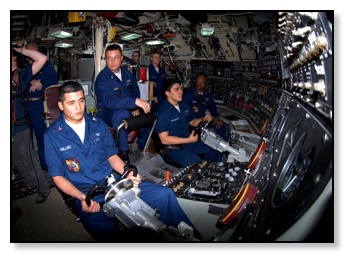
- The Helm steers the ship (with the rudder) and controls the sail or bow planes (one or the other depending on ship class), and the Outboard controls the angle on the ship with the stern planes. The Dive supervises the Helm and Outboard, as welll as the Chief of the Watch, who controls the submarine's buoyancy as well as raises the submarine's masts and antennas.
Inside the Operations Compartment - Control Room (Traditional Type)
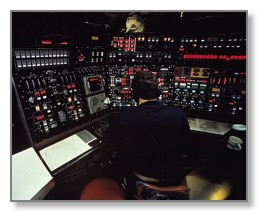
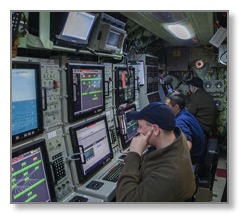
- Along the starboard side of the submarine are the Combat Control Consoles, where the submarine's crew determine a target's course, speed, and range, assign torpedo presets, launch their torpedoes, monitor their status after firing, and can even send followup commands after firing. (More on that in the armament section.)
Inside the Operations Compartment - Control Room (Virginia Class)
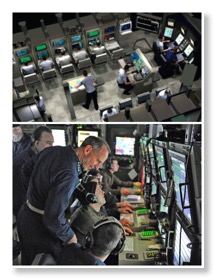
- If you think this is heresy, just wait - there are no longer Dive, Chief of the Watch, Helm, or Outboard watchstanders. On Virginia class submarines, these four watchstanders have been replaced with... wait for it... a Pilot and Co-Pilot who sit at the Ship Control Panel.
- I know, for you submarine veterans I probably should have ensured you didn't have any food in your mouth before I told you so you didn't choke. And the Officer of the Deck gives maneuvering orders - "Pilot, ahead standard, right full rudder." I kid you not.
Inside the Operations Compartment - Sonar Room
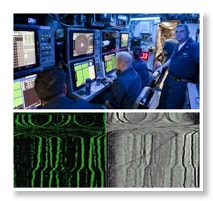
- Actually, the Sonarmen "look" for contacts more than listen, and the bottom half of the picture gives you an idea of what they're looking for, although current displays are more advanced. Each bright green trace represents a contact, and the upward angle of each trace represents their movement over time, which can be correlated to a specific course, speed, and range.
Inside the Operations Compartment - Radio Room
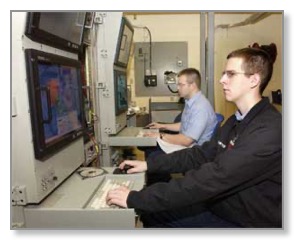
- Normally, a submarine proceeds to periscope depth and "copies or downloads the broadcast" through a receiver on top of one of its periscopes. Other communication circuits require raising a specific antenna from the sail.
- SSBNs also have two floating buoys they deploy while on patrol that float near the surface, allowing the submarine to stay several hundred feet beneath the ocean's surface, yet stay in constant communication.
- Submarines also have what's called the "floating wire" they can deploy from their sail, that they stream behind them several hundred yards like a gigantic antenna, also allowing them to stay in constant communication while submerged (at times).
Inside the Operations Compartment - Torpedo Room

- In the top left picture, you see a torpedo strapped in a stow aboard a 688 class submarine. In the top right, you see a somewhat spacious Virginia class Torpedo Room. That's because the torpedo cradles on the Virginia class are removable, and in the picture, the center stows have been removed. This gives the Virginia class flexibility to reconfigure their Torpedo Rooms so they can store other gear or configure them into SEAL mission control centers, for example.
- In the bottom left picture, a Torpedoman (they're Machinists Mates now - no more "Torpedomen") is in a tube for maintenance, and in the bottom right, he's preparing to fire the tube locally. (Normally, they're fired from one of the Combat Control Consoles in Control.)
Inside the Submarine - Berthing
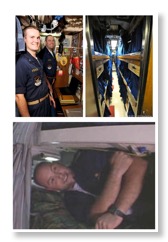
Officer "Staterooms" have the same bunk arrangements - stacked 3 high, although "stateroom" is a misnomer. The 3 officers assigned to a stateroom (top left picture) can't stand up at the same time without bumping into each other. However, officer staterooms have two fold-down desks and a fold-down sink, so they're quite luxurious compared to enlisted berthing.
Inside the Submarine - The Heads (Bathrooms)
Bathrooms aboard navy ships are called "heads", earning their name from sailing days, when they were located at the bow, or head of the ship.
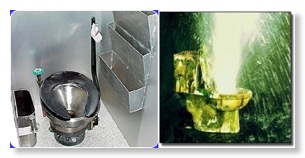
- The 2nd important difference is that the submarine has to discharge its sanitary tanks every so often. On the older classes (i.e. 688), they pressurize the sanitary tanks and blow them overboard. This is critical, in that you don't want to flush a toilet while a tank is being blown overboard. VERY critical. The toilets are flushed by opening a ball valve that lets the toilet contents flow down into the tank, but if you open the ball valve while the tank is pressurized - see the right side photo for what happens. And yes, it DOES happen. At least once a patrol, it seems a new crew member forgets, despite the sign hanging on the commode door, and he tries to flush the toilet while the tank is being blown overboard. VERY messy."
Inside the Operations Compartment - Auxiliary Machinery Space / Room
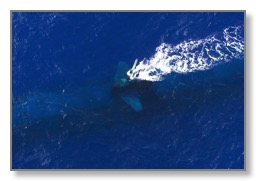
- The submarine has to come to periscope depth and "snorkle" - poking its snorkle mast above the surface of the water - while running the diesel, since it's a combustion engine and needs air. (See photo)
- Atmosphere control equipment (oxygen generators, etc.) are sometimes located in the Auxiliary Machinery Space and sometimes in the Engine Room. More on this equipment in the "Air and Water" topic.
Inside the Operations Compartment - Battery Compartment

- The submarine's battery isn't one "battery", but typically 126 battery cells connected together. (Think of it as a really powerful D-Cell flashlight.) Each cell is quite big, as you can see in the picture - about 1' x 1' x 5' tall.
- As the battery is drained, it's monitored to ensure none of the cells begin "reversing" polarity, which means they've become drained, and they begin charging themselves at the expense of the remaining battery cells. At that point, you're in big trouble.
Inside the Submarine - Missile Compartment
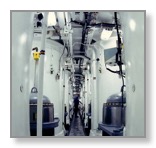
Inside the Submarine - Reactor Compartment
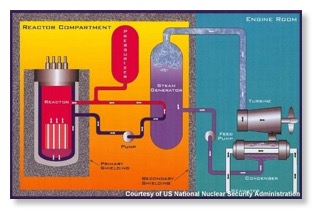
- Today's submarine reactors contain enough fuel to power the submarine for its entire life - no refueling required.
Inside the Submarine - Engine Room
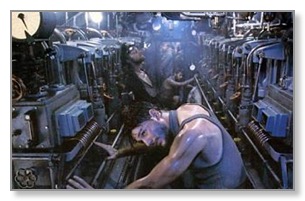
- Submarines normally have 2 of everything that's important, just in case one breaks. (We break a lot of stuff.) - 2 main engines, 2 electrical turbine generators, 2 motor generators (for charging to and from the battery), and sometimes 4 of them depending on the submarine class - 4 main feed pumps, 4 condensate pumps, etc. (We apparently break a lot of those.) However, we have only one propellor shaft. Break that and we're, well... we're up the creek without a paddle.
- I couldn't find a good picture of an American submarine Engine Room, because they're a huge, multi-level compartment and photos aren't usually allowed in the Engine Room anyway, so I'll leave you with this one of Das Boat.
Inside the Submarine - Maneuvering Room
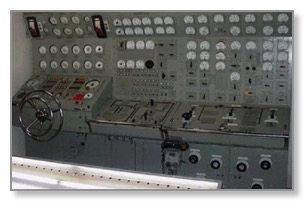
- The enlisted men each sit in front of a panel - the middle panel is manned by a Reactor Operator, who changes the height of the reactor control rods and the speed of the reactor coolant pumps. The panel to the right is manned by an Electrical Operator who controls the Turbine Generators that generate electricity and the Motor Genrators that either charge or discharge the battery, and the panel on the left is manned usually by another electrician, who is qualified as Throttleman and is in charge of the Steam Plant. The Throttleman's most important duty is to answer propulsion bells from Control. When the Officer of the Deck orders a new "bell", the Helm "rings up" the new order on the "Engine Order Telegraph" next to him in Control, which relays it back to the Throttleman, The Throttleman then spins the circular "throttle" at his panel to the ordered bell, which opens or closes the valves at the main engine turbines, allowing more or less steam into them.
Well, that’s it for the tour inside the submarine! Click on the link below to take you back to the list of topics at the top of the page, or continue on to the next topic, Submarine Armament!
Return to List of Topics
Topic 3: Submarine Armament (Weapons and Countermeasures)
Submarine Armament - Weapons and Decoys
Welcome to the third topic of Submarine 101 - the weapons and decoys submarines carry. I'll start with the submarine's most important weapon - the MK 48 Torpedo.
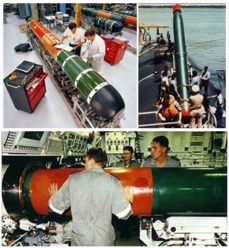
- Unlike WWII torpedoes, which were "straight-runners", modern torpedoes like the MK 48 have sonars in their noses and are artificially intelligent. They'll ping, process the returns, then decide what to do. If an enemy submarine ejects decoys, the torpedo will attempt to differentiate between the submarine and decoy. Also, the MK 48 torpedo trails a thin wire that stays connected to the submarine, and the crew can send commands to the torpedo, such as turn left or right, change depth, or other commands that will enhance the torpedo's probability it will detect the target.
- There are currently 3 “Mods” of MK 48 torpedoes in the Fleet, and the main difference between them is the Guidance and Control Section (i.e. the brain of the torpedo):
- Mod 6, which is referred to as the “legacy” Mod, since their G&C’s are built with MILSPEC parts.
- Mod 6 ACOT, where the ACOT G&C is an exact replacement for the legacy Mod 6 G&C using Commercial Off-the-Shelf (COTS) components.
- Mod 7, which is a Mod 6 ACOT with a Broadband Signal Amplifier Receiver (BSAR) instead of a discrete signal receiver, which gives the Mod 7 more capability.
Submarine Armament - Tomahawk Missile
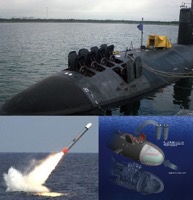
- SSGNs (guided missile submarines) can also launch Tomahawk torpedoes, with 22 of their 24 tubes capable of launching 7 Tomahawks each, for 154 total, depending on how the SSGN is configured.
Submarine Armament - D5 Ballistic Missile
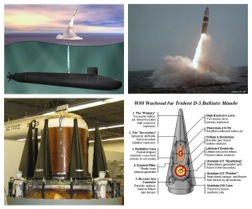
- Thankfully, the crew is well trained and there are many safeguards in place to prevent the inadvertent or unauthorized launch of any of these missiles, and I had to work REALLY hard in The Trident Deception to come up with a plausible scenario where these safeguards could be bypassed to the point where the reader could press the "I believe" button. (You'll have to read the book to find out what I came up with, and it'll be interesting to see what you think of my scenario.)
Submarine Armament - SEALs (Fast Attacks)
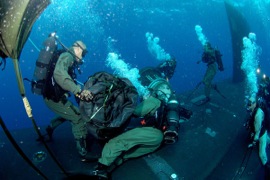
Submarine Armament - SEALs (SSGN - Dry Deck Shelters)
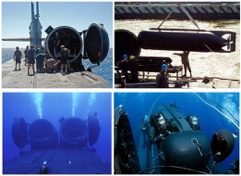
An SDV is a 4-man mini-sub capable of being launched from the DDS while the SSGN loiters off the coast submerged. The team of SEALs traverses toward shore submerged in their SDV, returning when their mission is accomplished.
Submarine Armament - SEALs (SSGN - RIBs)
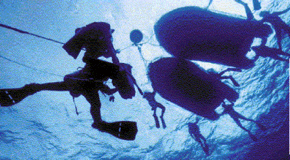
- SSGNs also have one of their Missile Compartment levels converted into extra berthing, so they can carry 2 platoons of combat SEALs. The 2 platoons of SEALs can exit the submarine, retrieve and inflate their RIBs and attach their motors, and be heading to shore within minutes.
Submarine Armament - Torpedo Decoys (Countermeasures)
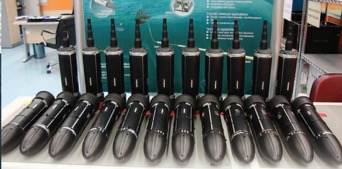
- Noisemakers that try to deafen the incoming torpedo, so it can't hear (detect) the submarine as it tries to evade.
- Decoys that try to mimic the acoustic signature of the submarine and convince the torpedo to follow it instead of the submarine trying to evade.
The combination and sequence of countermeasure employment is classified, so unfortunately, in The Trident Deception, I simply referred to "countermeasures" as torpedo "decoys" in general, without stopping to explain the differences between the various types or their employment.
Return to List of Topics
Topic 4: Submarine Crews
Welcome to Topic 4 of Submarine 101 - Submarine Crews!
Crew Complement
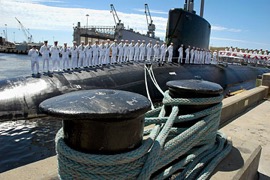
The officer "wardroom" is comprised of the:
- Commanding Officer
- Executive Officer (second-in-command)
- 4 department heads: the Engineer Officer or "Eng", responsible for the nuclear reactor, the propulsion plant, and all basic mechanical and electrical systems, the Navigator or "Nav", responsible for the navigation and radio divisions, the Weapons Officer or "Weps", responsible for the submarine's torpedo, sonar, and missile divisions, and the Supply Officer or "Suppo", although many have not broken the habit of calling the man responsible for serving the pork and beans, "the Chop".
- The rest of the officers are junior officers on their 1st submarine tour.
The enlisted personnel are broken down into the following divisions:
Engineering Department
- Auxiliary (non-nuclear Mechanical)
- Electrical
- Mechanical
- Reactor Controls
- Reactor Laboratory
Operations Department
- Navigation
- Radio
Supply Department
- Culinary Specialist (Cooks)
- Supply
Weapons Department
- Torpedo
- Sonar
- Fire Control
- Missile (on SSBNs)
There's also a Medical Department headed by a Corpsman, and I'll talk about that at the end in the section titled "When Things Go Wrong."
Blue and Gold Crews
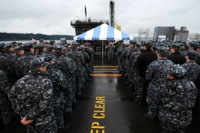
- While one crew is at sea, the other crew takes on replacements for personnel who have transferred or left the Navy, then trains and certifies the new strategic, navigation, and tactical teams in training centers ashore, and also gets some well-deserved time off with the family.
- Once the boat returns, both crews work together during its "Refit" period before the other crew departs on patrol.
Women on Submarines
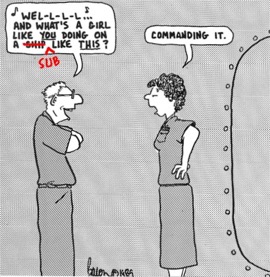
- The argument against women on submarines (as I understand it) has been the difficulty of accommodating them due to privacy concerns (no separate berthing or bathroom facilities) and radiation concerns (to the unborn child before you know you are pregnant). However, those concerns have apparently been addressed and the barrier removed.
- The first female officers will be stationed aboard Ohio class SSGN and SSBNs, and also on select Virginia class submarines.
- As a note, this is not something new to submarines - just the U.S. Navy. Foreign navies have had women serving aboard their submarines for decades in some cases. For any upset bubbleheads out there, my favorite quote I've heard to date is: "Easy guys - we let nukes aboard. Women should be easy."
P.S. For non-bubbleheads, nukes = nuclear trained personnel.
Speaking of women on submarines, below is a photo of my wife and me, atop the sail of USS Kamehameha in 1994, while underway for a Dependents Day cruise.
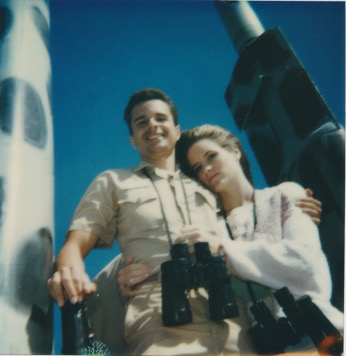
Return to List of Topics
Topic 5: Submarine Deployment Information and Preps
Submarine Deployments - Patrol / Deployment Duration
Welcome to Topic 5 of Submarine 101 - Deployment Info. I'll start with the basics - how long do submarines go on deployment?
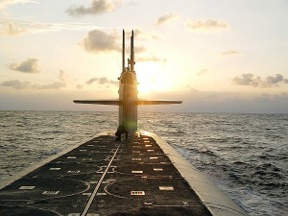
- Fast attacks (SSNs) typically have an 18 month cycle, during which they deploy for 6 months.
- Guided Missile submarines (SSGNs), like SSBNs, have 2 crews and conduct a deployments similar to a fast attack, although the missions are different.
Once submarines return from deployment or patrol, the crew usually gets some well-deserved time off, personnel transfer and replacements arrive, and the crew begins the process of training and melding back into a finely tuned team.
Submarine Deployments - Crew Certification
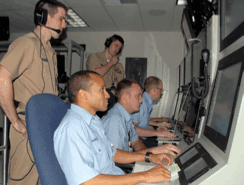
- Each formal team trainer is usually a week long evolution, although the crew can get extra time if it appears they need it.
Submarine Deployment Cycle - Refit / Upkeep
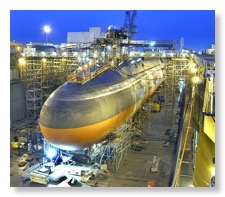
- When not on deployment, about once a quarter, each submarine enters an Upkeep (fast attack) or Refit (SSBN/SSGN) maintenance period, which lasts about four weeks, during which the submarine is repaired to full capability.
- After the maintenance period, the submarine goes to sea for what's called "sea trials" where it tests out the repaired systems, which normally includes a controlled dived down to test depth.
- Submarines don't normally enter drydock for their quarterly maintenance - it's normally done pierside. But every so often they enter drydock for more extensive maintenance.
Submarine Deployment Preps - Loadout
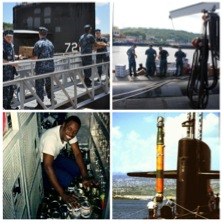
- On older ship classes, the food has to be loaded manually, box-by-box as you see in the top two photos of the post, while on TRIDENT submarines (Ohio class) there are removable 8 foot diameter (about) Logistics Escape Trunks that allow the food to be pre-loaded into their supply room containers, then lifted by crane and lowered into the submarine and slid and locked into place in the supply storage room. A whole lot easier.
- I'll provide more detail about the food loadout when we get to the Food section in Topic 8.
Submarine Deployments - Stuff for your Wife

- You'll also have to make arrangements for everything you'll miss while you're gone. You'll write letters to your wife that she can open once a week, and you can write stickies or notes you'll hide around the house for her to find while you're gone.
- Don't forget the special holidays you'll miss while you're gone, so you'll have to pre-order the Valentine's and Mother's Day flowers, and buy and wrap the birthday and Christmas gifts, and don't forget the cards either.
Submarine Deployments - Stuff for your Kids

- You can also write notes ahead of time that your wife can put inside their lunch box or bag periodically while you're gone.
- This is a picture my oldest daughter carried around with her every day for an entire patrol.
Return to List of Topics
Topic 6: Underwater Operations
Welcome to Topic 6 of Submarine 101. After 5 lessons of the basics, we're finally ready for what you've probably been waiting for - we're getting underway!

- Once we're in deep enough water, the Captain (although his rank is a Commander except on SSGNs) will give the order to submerge the ship (lots of preps before that but can't cover them here). The Main Ballast Tank (MBT) vents will be opened, allowing air to escape and water to flood up through grates in the keel, and the sub will gradually sink into the ocean.
- The "Compensation" is critical. After a submarine is in port for a long maintenance period, supplies and spares are loaded, and diesel fuel and water are topped off, etc. It can be difficult to estimate the exact weight of the submarine. This estimation and adjustment back to neutral buoyancy is called "The Compensation", and it's critical to get it right. If the submarine is too heavy, once the air escapes from the MBTs, the sub will continue to sink toward Crush Depth and the crew will have to "catch and carry the extra weight" with speed and ship's angle until the extra weight can be pumped off. If the sub is too light, is won't sink at all (not dangerous but professionally embarrassing).
- The photo in the post is of an SSGN submerging, venting its MBTs, What looks like smoke is simply water spray, being blown upward by the air escaping from the MBT vents, fore and aft.
Underwater Ops - Controlling Course and Depth
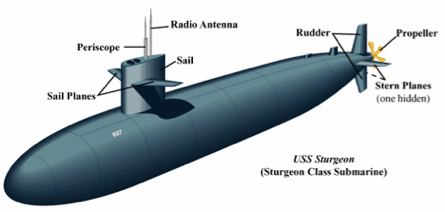
- The ship's depth can also be fine tuned by another set of planes called the Sail Planes or Bow Planes, depending on the submarine class. Older classes - 688 1st Flight and Ohio Class (SSBN) - have Sail Planes, while newer classes have Bow Planes.
- Bow Planes provide more maneuverability, but the Navy resisted moving the planes closer to the sonar sphere in the bow due to the mechanical noise associated with moving the bow planes around, but advances in technology allowed the development of quiet bow plane mechanisms.
Underwater Ops - Going to Periscope Depth
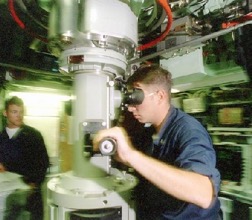
- Also, when a submarine comes shallow, due to the ocean's thermal layer, it will often pick up new contacts - sometimes dozens, and have insufficient time to determine each one's course, speed and range before it much come up to copy the radio broadcast or transmit a message. The submarine's crew must simply convince themselves that none are close enough to pose a collision threat during the ascent to periscope depth.
- During an ascent to periscope depth in a high contact density environment, it can be quite tense in Control, and protocol during all ascents to periscope depth is that there is no talking in Control, aside from the Diving Officer's depth reports, from the time the Officer of the Deck gives the order to proceed to periscope depth, until the periscope breaks the surface of the water and he announces "No close contacts", or gives the order "Emergency Deep".
Underwater Ops - Surfacing and Emergency Blow
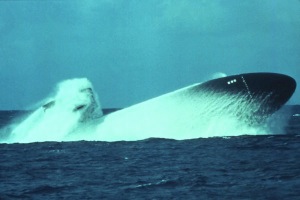
- Once the water has been blown out of the MBTs, the submarine is firmly on the surface and the submarine can slow down and its stern planes can be repositioned and locked into their surface running mode.
- An alternate method of surfacing, used in an emergency, is the Emergency Blow. In this case, switches are actuated in the submarine's Control Room which open valves that port 4500 pound air to the MBTs, forcing the water out of the tanks, making the submarine lighter very quickly. The submarine races to the ocean's surface, like a cork held deep underwater and then released.
Underwater Ops - How do you know where you are?
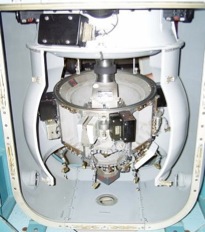
- A couple of ways. They can go to periscope depth and obtain a GPS fix from satellites in orbit. But a submarine's primary means of navigation between fixes are its "inertial navigators". Two identical complicated machines that measure small changes in gravity to figure out in which direction the submarine is moving. These updates are fed to a navigation chart and compared to each other. As long as they're both tracking together, life is good.
- The photo in the post is a cutaway of an older inertial navigator. These devices use small beryllium balls spinning around at thousands of revolutions per second, and variations of these navigation devices are also used on missiles. If you've heard the term ' "spinning up all missiles" as they're brought on-line for launch, it's a reference to their inertial navigators "spinning up" their beryllium balls.
Underwater Ops - Tracking Targets
- The big difference between radar and sonar is range information. Radar delivers both bearing and range information. Submarines however, normally use passive sonar, which provides only bearing information. As a result, when a contact is gained, you know what bearing it's on, but you don't know how far away it is, its speed, or its course. It could be a mile away heading east, or ten miles away heading west. So you can't shoot - just yet. You need to figure things out.
- Fortunately, you can. There are ways to evaluate a contact's bearing and eventually determine its range, course, and speed. But it takes time. And if it maneuvers to a new course and speed while you're trying to figure it out, it makes it that much harder. When two submarines engage in a cat-and-mouse game hunting each other, each one constantly changing course and speed, it can be a nerve-wracking and time-consuming ordeal until one submarine crew decides they have a firing solution.
Return to List of Topics
Topic 7: The Daily Routine
Welcome to Topic 7 of Submarine 101! Now that we're underway and you've got the hang of how the submarine maneuvers and tracks contacts, we'll settle into the daily routine. First up - The Watch Cycle.
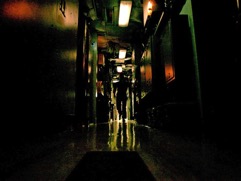
- For example, if a section has the Midwatch (midnight to 0600), they'll get off and eat breakfast, then most likely have drills on the morning watch, training on the afternoon watch, then back on watch for the evening watch. So - they'll often be up for 24 hours straight without sleep, every third day. They'll try to catch an hour or two down here or there, but sometimes can't, depending on the ship's schedule or real-world ops.
The Daily Routine - Drills, Drills, Drills
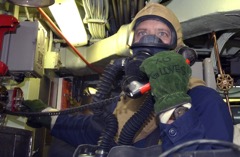
- Ship wide, the crew runs flooding and fire drills, torpedo "hot run" and other emergency drills when at Battle Stations, attempting to anticipate every type of malfunction or battle damage than can occur during combat.
The Daily Routine -Training and Qualification
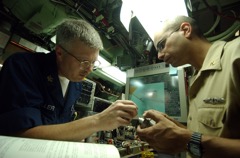
- Then there's the advancement exams you'll be studying for so you can get promoted if you're enlisted, or qualify as Engineer or for Command if you're an officer. The studying never ends.
The Daily Routine - Maintenance
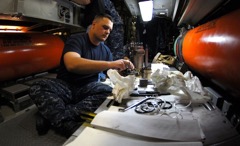
- Navy ships also have a maintenance philosophy called "Preventative maintenance", where equipment is "maintained" according to a set schedule. Sorta like taking your car in for an oil change every 15,000 miles. A good portion of a crew member's 12-hour "off time" is dedicated to maintenance.
The Daily Routine - Off-Watch Pastimes
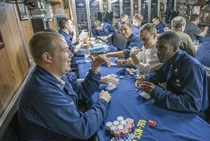
- Each evening, most submarines show a movie in the Crew's Mess at 8 pm, with popcorn, plus some of the crew will gather to play cards. One of the traditional naval card games is cribbage, although the photo looks like Saturday night poker,
The Daily Routine - Working Out
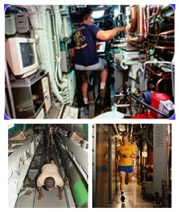
- If the submarine's operational situation permits it (the risk of you dropping a weight or otherwise clanking around), a crew member will typically work out after they come off watch or before they go on. There won't be much equipment on board however. There's no standard equipment either - each submarine jams whatever they think they can fit aboard - typically one or two stationary bikes, maybe a rowing machine, a versa-climber, sometimes a treadmill. Some of the SSBNs, which have more room, have a universal style weight machine, and a lot of submarines will have a work bench with adjustable dumb bells, maybe a weight bar. Everything is focused on cramming as much utility into as little space as possible.
- You can also get a decent run in on our SSBNs - 17 laps around Missile Compartment Upper Level is one mile. (Did I mention our SSBNs are pretty big?)
The Daily Routine - Sledding, Anyone?
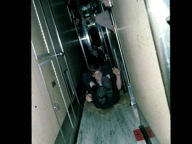
- Submarines use a plasticy insulated flooring in some of its compartments, which is somewhat slick, and with a steep enough angle and the right "sledding" equipment, you can get up a pretty good head of steam.
- The tricky part isn't getting going though; it's stopping once you reach the far bulkhead.
Return to List of Topics
Topic 8: Submarine Food
Welcome to Topic 8 of Submarine 101! By now you're probably hungry, so we finally get to the topic of - Food! What's the food like aboard submarines? We'll start with - The Loadout.
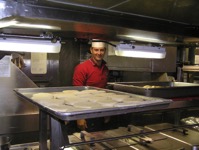
- 500 pounds of coffee
- 800 pounds of butter, and
- 22,000 eggs
Due to space limitations, many items are baked aboard the submarine rather than brought aboard already made. There's a Night Baker assigned to bake the white bread needed for sandwiches and toast, along with dinner rolls, hamburger and hoagie buns, and all the pastries, cakes, and cookies. And nothing tastes better than pies and cookies right out of the oven.
Submarine Food - The Menu and the "Meat Identifier"
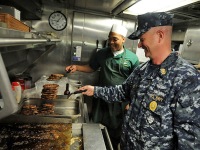
- The menu is usually on a rotation, but each Saturday is usually the same - typically "sliders' and chocolate chip cookies for lunch and pizza for dinner. "Sliders" are hamburgers, nicknamed "sliders" because if you're cooking the patties on the grill and the submarine takes an up or down angle...
- As I mentioned, the menus are on a rotation, and each main course (chicken, pork, steak, etc.) is usually paired with the same side dishes. For example, if you walk into the Wardroom and see applesauce on the table, you know you're having pork for dinner. Applesauce in this case is - the "Meat Identifier".
Submarine Food - Fresh Veggies and Milk

- What? Submariners afraid of irradiated milk? C'mon.
Submarine Food - Eating in Crew's Mess and the Wardroom
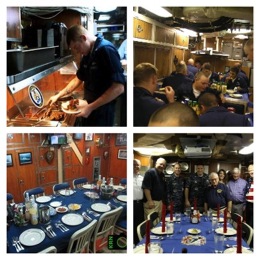
- The Crews Mess is cafeteria style - grab your tray and utensils and pick out the food you want, then sit down wherever you want with your buddies, as you can see in the top two photos.
- The Wardroom is much more formal, as you can see in the bottom two photos. The officers are seated by seniority, with the Captain on one end of a rectangular table that seats 12 and the Supply Officer on the other end. No one sits until the Captain sits, then each course is brought out individually (soup, salad, main meal, dessert/coffee), and no one begins eating each course until the Captain begins, and no officer may leave the table unless he is excused by the Captain. The only exception is the 2 on-coming watch officers may eat ahead of the Captain, as they need to eat quickly so they can relieve the watch, and the two off-going watch officers eat at "second-sitting".
Submarine Food - The Ice Cream Machine
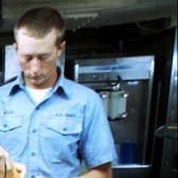
- Some will say it's the nuclear reactor that provides power, others will say it's the torpedo tubes so they can defend themselves, and others will say it's the main engines that carry them to safety.
- Nope. The most essential piece of gear aboard a nuclear powered submarine is the ice cream machine.
- Submarines have a soft-serve ice ceam machine that typically serve vanilla or chocolate ice cream (whatever mix they happen to have), and that's one piece of critical gear that better stay working the entire deployment or patrol.
Submarine Food - What do you do with the Garbage?
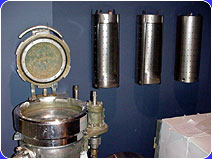
- The stuff that isn't biodegradable (i.e. plastics), gets cleaned up and stored until the submarine returns to port.
Submarines - A Tasty Snack?
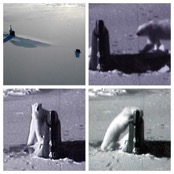
Return to List of Topics
Topic 9: Submarine Air and Water
Life Aboard Submarines - Water, Water, Everywhere & Not a Drop to Drink!
Welcome to Topic 9 of Submarine 101! Earlier I introduced you to submarine food. Now it's Water (and Air). I'll start with - Water.

- Drinkable water, and even purer water for the propulsion plant, is created by a submarine's evaporator - basically a tea kettle that boils the seawater and condenses the steam into pure water. However, evaporators have been replaced with new Reverse Osmosis machines, which filters out the impurities in the seawater.
- But submarines can make only so much water per day and water supply is limited, so water faucets are designed to shut off after a few seconds, and the crew is trained to take "submarine showers", as I mentioned in Topic 4.
Submarine Air and Water - Where does the oxygen you breath come from?
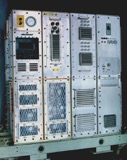
- Submarines have one or two oxygen generators (depending on the submarine class) that break water molecules into their oxygen and hydrogen atoms. The oxygen atoms combine to form breathable oxygen (O2), and the hydrogen is pumped overboard.
- Submarines also store oxygen in oxygen banks for an emergency in case both oxygen generators go down, or if the submarine sinks and loses power, they can bleed oxygen from the banks.
Submarine Air and Water - Carbon Dioxide "Scrubbers"
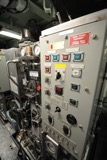
- There are lots of other impurities in a submarine's atmosphere besides carbon dioxide which must be removed (besides the smell of your buddy's socks and sneakers). In addition to Carbon Dioxide Scrubbers, submarines also have Hydrocarbon "Burners", which remove lots of other impurities from the air.
Submarine Air and Water - That Funny Smell
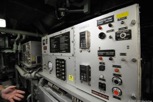
Submarine Air and Water - Smoke Break?

Return to List of Topics
Topic 10: Submarine Training and Inspections
Submarine Training and Inspections - Training, Training, and more Training
Welcome to Topic 10 of Submarine 101! Here I'll run you through the training and certifications submarines go through.
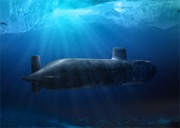
- In these cases, one submarine will be restricted to operating shallow with the other one deep, so that they don't run into each other if they happen to cross paths.
Submarine Training and Inspections - Submarine Command Course (SCC)
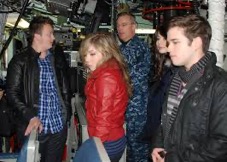
- SCCs culminate in a weeklong exercise at sea, with the class of PXOs and PCOs split between 2 or 3 submarines with their torpedo rooms loaded to the gills with exercise torpedoes, going head-to-head day and night.
- I couldn't find any photos of Command Course officers in Control, so I went with this one. Bonus points to anyone who identifies the teenagers in the Control Room of this submarine. (You'll have a leg up if you have elementary school age kids.)
Submarine Training and Inspections - Operational Reactor Safeguards Examination (ORSE)

- There's a lot of teamwork involved in the proper operation of the reactor and propulsion plant, and the workup for the inspection can be grueling. The photo is a T-shirt one of the 3 watch sections created during the workup for an ORSE when I was the Engineering Officer. Submariners can be somewhat cynical, as the T-Shirt depicts the section failing the inspection in epic fashion, blowing the ship up during the ORSE. Of course, submarine nuclear reactors can't actually blow up.
- The T-shirts were worn hidden beneath their blue coveralls, and the watch section did fantastic.
Submarine Training and Inspections - Tactical Readiness Examination (TRE)
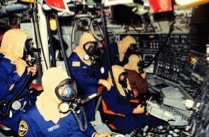
Submarine Training and Inspections - Other Inspections (Supply, MS, etc.)
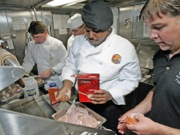
Submarine Training and Inspections - Fires and Flooding
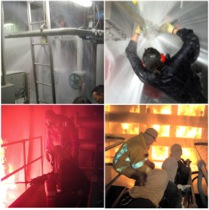
- Fire is the next most dangerous hazard, as the submarine is a closed environment, and the compartments fill up quickly with toxic gases and thick black smoke. The fire can spread rapidly, destroying vital equipment.
- So the crew trains constantly, both ashore and at sea, honing their skills against these two casualties. Here you see pictures of shoreside Flooding and Fire trainers, giving the crew hands on experience they can't get while on board the submarine.
Return to List of Topics
Topic 11: Submarine Halfway Night and other Rituals
Welcome to Topic 11 of Submarine 101! Here I’ll cover some submarine rituals and other fun stuff!
Submarine Rituals - Halfway Night

- Pie in the Eye. Whipped cream pies auctioned off to the highest bidder, who gets to throw them at his favorite crew member, officers included (one night only!) Not the Captain, though, and some XO's are off-limits. When I was XO, I was fair-game. (I raised a LOT of money.)
- Another auction determines who serves the food in Crews Mess and the Wardroom, and cleans up afterwards. Typically a few officers will get tagged with this "honor".
- Another auction will determine which enlisted will get to eat in the Wardroom, or even sit in the Captain's chair, or even be the "Captain for a day".
- All-in-all, Halfway Night is a time for the crew to let down their hair and break through the formality barrier between officers and enlisted. It's a fun night, and everyone looks forward to it.
Submarine Rituals - Shellback
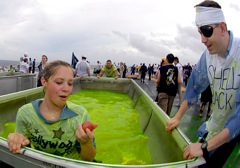
- It's all in fun and the ceremonies used to be pretty gross, but they've been toned down over the years. But basically the fattest guy on the crew becomes King Neptune for the day, appropriately regaled with crown and scepter, and Pollywogs have to pay homage and do his bidding, appropriately supervised by Shellbacks who have thought up some pretty interesting events, which may or may not include sucking a cherry out of King Neptune's belly button.
- Crossing the equator and becoming a Shellback is not only a submarine tradition, but a surface ship and an international Navy tradition. I couldn't find any good (i.e. appropriate) submarine photos, so here's one from an aircraft carrier, where it looks like the Pollywog had to dive under the "slime" and pick up the "apple" with her mouth.
Submarine Rituals - Blue Nose

- Blue Nose rituals will involve the pre-Blue Nose somehow getting really cold and getting a blue nose.
Submarine Rituals - Panama Canal Passage
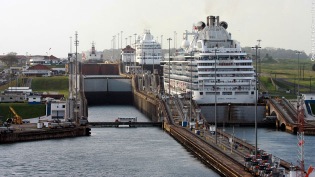
- The Panama Canal is above sea level, so the locks raise the ships up in stages, then the ships transit across the picturesce countryside through canals with steep, sloping cliffs, which connect various lakes, until you reach the Miraflores locks, which lower you down to the Pacific Ocean.
- The maximum width of almost all ships is dictated by the width of the Panama Canal. In the photo you can see several cruise liners in the canal, and what a tight fit it is.
Submarine Rituals - Steel Beach Picnic
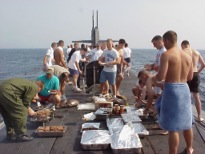
- The cooks will bring a Bar-B-Q grill topside, grill some burgers and hot dogs, and the crew will kick back and relax. The cooks will even send up some burgers and dogs to the Officer of the Deck and Lookout, stationed on the Bridge.
Submarine Rituals - Swim Call
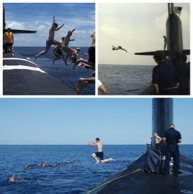
- One note: we're always on the lookout for sharks, so we post an extra lookout in the Bridge with a rifle. The joke is - he's not there to shoot the shark, just the farthest guy out, so the rest can make it back.
Return to List of Topics
Topic 12: Submarine Pranks
Welcome to Topic 12 of Submarine 101! This is a fun topic - Submarine Pranks!
Submarine Pranks - The Mail Buoy
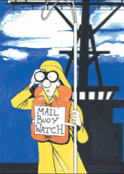
- So Deck Division, who normally has the newest recruits assigned, will select an unfortunate soul for the duty, and have him dressed in foul weather gear, life preserver, deck harness, boat hook, etc, ready to head topside, and send him to the Control Room to request permission to head topside to retrieve the mail buoy. The Officer of the Deck will of course, decline permission, since there is no such thing as a mail buoy.
- From the cartoon I found, apparently the Mail Buoy prank is a surface ship as well as a submarine prank.
Submarine Pranks - Relative Bearing Grease
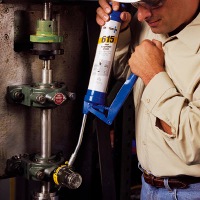
- The prank on a new seaman is - his division is doing maintenance, and the Chief will send the seaman to the Supply shack for grease for the "Relative Bearing" they're about to install, and he needs to hurry so he doesn't hold up the maintenance. So the seaman hustles to Supply, where the Supply Chief will check, and sure enough, he'll be out of "Relative Bearing" grease. But he issued the last batch to Machinery Division in the Engine Room - the seaman should check with them. So the seaman scurries to Shaft Alley only to find out that M-Div used the last of their Relative Bearing grease that morning. But M-Div says that Torpedo Div near the bow has some. So the seaman hustles to the front of the submarine and checks with Torpedo Division, but alas, they're all out too. But they think A-Div might have some. And so it goes, the seaman bouncing around frantically searching for Relative Bearing grease, knowing his Chief is waiting for it, until he finally figures out there is no such thing as a "Relative Bearing" or someone eventually clues him in.
Submarine Pranks - Shooting Water Slugs
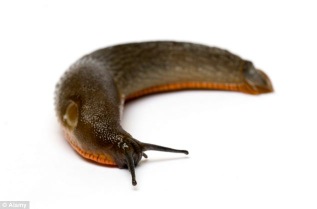
- Another submarine prank is to hand a bucket to a Seaman and tell him to head to the Engine Room and get a bucket of "water slugs" from the bilge (back when we had wet bilges). The chief would explain how the little creatures get into the bilges from pump drains and grow, and they have to shoot them out the torpedo tubes. The Seaman would head to the Engine Room, bucket and scoop in hand, where, of course, there are no water slugs in the bilge.
Submarine Pranks - The Missing Door
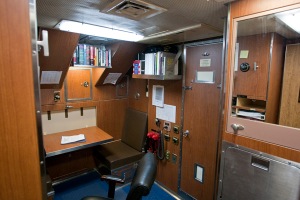
- The military officer-enlisted relationship requires the crew follow his orders and show the proper respect, but on patrol or deployment, the crew will sometimes pull a prank on the XO. One of those pranks is to remove the hinge pins and steal the XO's stateroom door for a while.
- I couldn't find a picture of an XO's stateroom - this one looks like a fast attack Commanding Officer's stateroom. The metal thing to the right is a fold-down sink, and above it is a medicine cabinet. You see a fold-down table with one of two seats at the back of the stateroom. The table folds up, and the Captain's bed then folds down from the bulkhead.
Submarine Pranks - The Mysterious Light
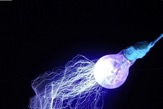
Submarine Pranks - Trim Party
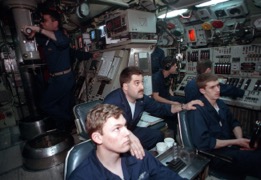
Submarine Pranks - A Little Bit Off Course?
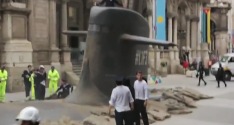
Return to List of Topics
Topic 13: Unusual Submarine Operations
Welcome to Topic 13 of Submarine 101 - Unusual Operations!
Unusual Submarine Operations - ICEX (Under Ice Exercise)
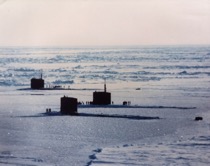
- Additionally, the near freezing temperatures place submarine weapon systems in unusual circumstances where they might not work. For example, I was at a base camp on the polar ice cap in 2009 and I pulled out my camera to take a picture, and it didn't work. The camera was so cold, the battery didn't function. I had to put the battery inside my thermal suit for a while to warm it up so it would work.
- Every few years, the Navy sends submarines under the polar ice cap to shoot exercise torpedoes at each other, to ensure they retain the tactical ability to prosecute enemy submarines under the ice, and to verify their weapon systems function in the harsh polar environment.
Unusual Submarine Operations - SINKEX (Warshot Live Firing)
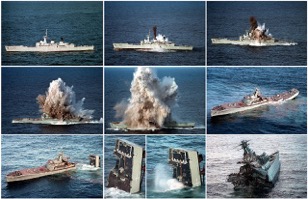
- These warshots are fired against decommissioned surface ships, like in the photo, or against fake targets (buoys with sonar repeaters that simulate a target)
- One interesting fact is that when fired against surface ships, Heavyweight torpedoes don't puncture the ship - they explode beneath the keel, and the void of water the explosion creates breaks the ship's keel, since there is nothing under the ship to support it, and the ship breaks into two pieces, as you can see in the photo.
Unusual Submarine Operations - FCET (Follow-on CINC Evaluation Test i.e. Ballistic missile launch)
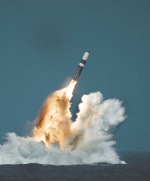
- Each year, the Navy performs an FCET, launching multiple missiles from an Ohio class ballistic missile submarine, verifying the submarine's weapon and launch systems, as well as verifying the missiles work properly.
Unusual Submarine Operations - Set-to-Hit Torpedo shots
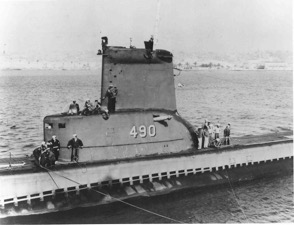
- Exercise torpedoes are prevented from hitting other submarines by "STRATUM" protection, operating in a different layer of the ocean, or in older variants, by a "turnaway" feature. But DT/OT testing often calls for "Set-to-Hit" shots against special targets to verify the final phases of torpedo homing, arming, and detonation (with fake warheads).
- In the attached photo, the submarine had a bad day - the Exercise torpedo malfunctioned, and its "Turnaway" feature didn't kick in. Notice how nonchalant they are with the torpedo sticking out of the submarine's sail. (It's because it's an Exercise torpedo, not a Warshot.)
Unusual Submarine Operations - TACDEVEX (Tactical Development Exercise)

- The attached photo is our newest submarine under development. Okay, just kidding. We don't actually have a flying submarine that can drill through mountains. The photo is from the 1963 movie titled Atragon.
Return to List of Topics
Topic 14: When Things Go Wrong
Welcome to Topic 14 of Submarine 101! You're almost home, and your fingers are crossed nothing goes wrong before you pull into port. Unfortunately, sometimes they do…
When Things Go Wrong - San Francisco Grounding
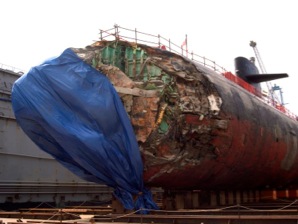
- The USS San Francisco was on its way to Australia, traveling at Ahead Flank speed, when it slammed into an uncharted underwater mountain. Of the 137 men aboard, 98 were injured, including one fatality. It was a miracle the San Francisco wasn’t sunk. The submarine's pressure hull survived intact, buffered by the ship's forward main ballast tanks as they crumpled into the mountain peak.
- After the submarine limped back to port, NAVSEA engineers determined the San Francisco's bow was a complete loss. There was no way to fix the hull and have any confidence in the durability and life span of the repaired ship. So they cut off the bow of the USS Honolulu on its way through decommissioning, welding it onto the front of the San Francisco in place of its mangled counterpart.
When Things Go Wrong - Kursk Explosion
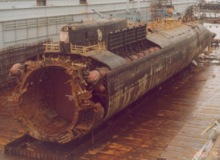
- The Kursk, minus its bow, was subsequently raised from the bottom a year later, as you can see in the photo.
When Things Go Wrong - Hartford and New Orleans Collision
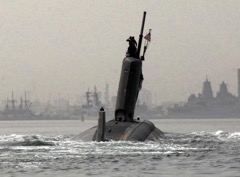
- The photo is a picture of the USS Hartford, after she collided with the USS New Orleans in the Persian Gulf while going to PD. (To add insult to injury, not only did she collide with a surface ship, she collided with one of our own warships.)
- You can see the sail of the Hartford is bent over, tilting to the side. It could have been disastrous - the collision almost ripped the sail from the top of the submarine.
When Things Go Wrong - TRIDENT D5 Missile Test Launch
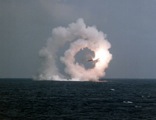
When Things Go Wrong - Call the "Doc"

- If you're stuck in the middle of nowhere and can't get access to the appropriate specialty, the "Doc" will handle it. Break a bone? Call the Doc. Need a dentist? Call the Doc. Need an emergency appendectomy? Postpone dinner and clear the Wardroom table and... call the Doc.
- The photo is titled "Submarine Appendectomy", from Esquire Magazine.
Return to List of Topics
Topic 15: Homecoming
Submarine Homecoming - A Sight for Sore Eyes
Welcome to the final topic of Submarine 101! Homecoming!
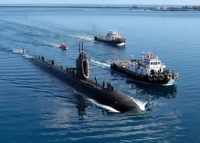
- It looks like this submarine is pulling into Pearl Harbor, since it's got a giant lei draped across the front of its sail.
- It's been a tough patrol or deployment, being away from your family, especially your kids, and by now, you're ready to trade your buddies in for some well-deserved time at home.
Well, that wraps things up! I hope you've enjoyed my Submarine 101 and learned a little bit about submarines along the way. I've had a lot of fun taking you on this virtual tour!
Return to List of Topics

